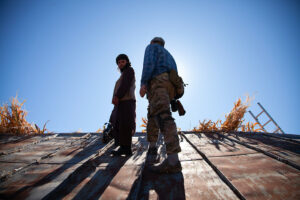Film Review: The Chaos of “Battle for Afghanistan” Exacts a Steep Price
Written by: Christopher Llewellyn Reed | August 12th, 2021

Battle for Afghanistan (Pavel Lungin, 2019) 2½ out of 4 stars.
War is chaos, especially when it drags on. Add to that the visceral human resentment towards foreign invaders, and you begin to understand how conflicts such as the Vietnam War or the U.S. occupation of Afghanistan could end in such disarray. Speaking of the latter, before the Americans arrived in 2001, Afghans had already experienced many an encroachment by would-be conquerors, from the Mongols in the 13th century to the British in the 19th (with others in between) and all the way up to the Soviets in the 1980s. It’s these last ones who are the subject of Russian director Pavel Lungin’s Battle for Afghanistan (original title “Bratstvo,” or “Brotherhood”), which follows the final days of the Red Army’s 1989 retreat from a never-ending battle they could not win. Flash forward 32 years, and the United States is now doing the same. The more things change, the more they stay the same.
Lungin (Queen of Spades) grounds his tale in events culled from the memoir of one Nikolay Dmitrievich Kovalyov, to whom he dedicates the film “in hallowed memory” (according to an opening title card). Before he went on to run the FSB (the successor to the KGB) in the late 1990s, Kovalyov served in Afghanistan. Here he is portrayed as “Dmitrich” (Kirill Pirogov, The Courier), an intelligence officer who finds himself in the unenviable task of looking for the kidnapped son of the general in charge of the last remaining troops. As the mujahideen (rebel fighters, many funded by the U.S., some of whom eventually morphed into the Taliban) prepare to fill the vacuum left by the Soviets, Dmitrich and a small, hardened band of operatives work to recover the lost soldier (a pilot whose plane was downed) before it is too late.

Lungin works in an elliptical manner, often jumping ahead to new scenes without bothering to fill in narrative gaps. It’s a refreshing approach, but also occasionally a confusing one. Then again, that is entirely the point of the exercise. In the maelstrom of struggle, nothing is supposed to make sense. Even better, despite his overly fawning blessing of the source material, Lungin eschews overbearing patriotic tributes to his nation’s efforts. Instead, Battle for Afghanistan serves as a warning against imperial overreach and the corrupting influence of unchecked power. His characters muse on what they rightfully see as the final days of the USSR. And though the movie centers itself squarely on the Russian point of view, it avoids dehumanizing the Afghans, even as it occasionally traffics in some stereotypes about them.
Unfortunately, despite a fine ensemble, the film struggles a little too often in its attempt to have the tone and form mirror the content. Though engaging, the plot remains ajumble, with some moments almost incoherent in the larger picture. The message is clear, however: hubris exacts a steep price. Perhaps we in America should have heeded the warning.


